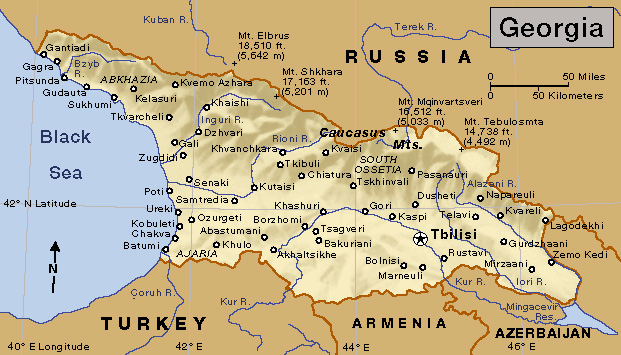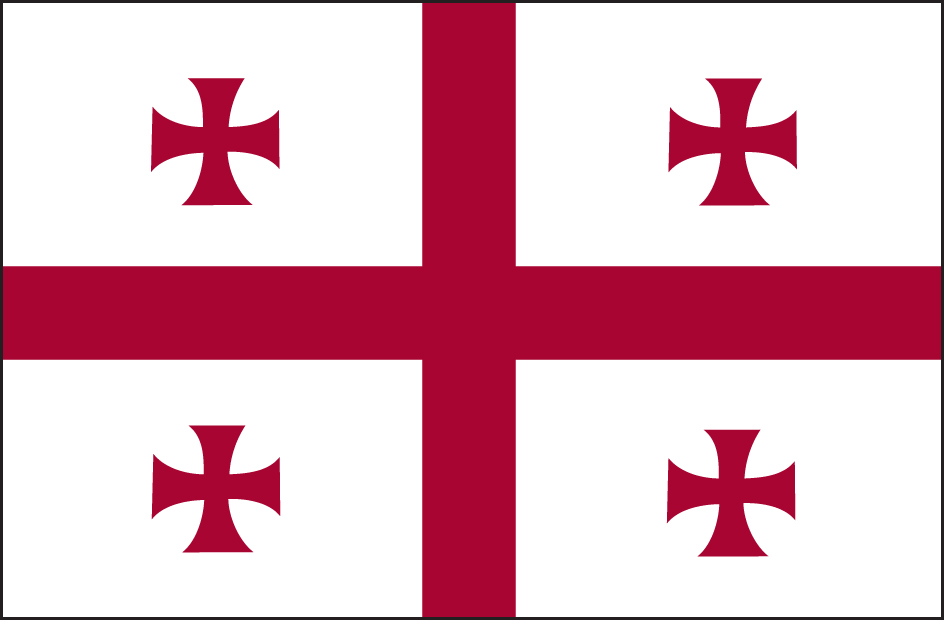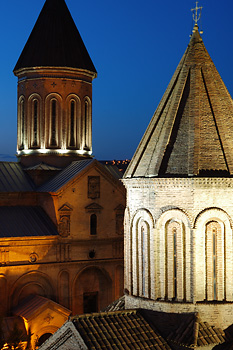Georgia is a country in the Caucasus Mountains at the eastern end of the Black Sea. It lies mostly in southwestern Asia, but part of northern Georgia is located in Europe. Tbilisi is the capital and largest city. Georgia became independent in 1991 after nearly 200 years of Russian and Soviet rule.

Government.
Georgia’s president is the country’s head of state. A prime minister oversees the operations of the government. The president chooses the prime minister with the consent of Parliament. The Georgian Parliament is a one-house legislature that consists of 150 members. The members of Parliament serve four-year terms.

People.
About 85 percent of the people are ethnic Georgians. The population also includes Abkhazians, Armenians, Azerbaijanis, Ossetians, and Russians.
Most people of Georgia are Christians who belong to the Georgian Orthodox Church. Some people are Muslims. The primary language is Georgian. The Georgian language is the principal language of the Caucasian language family. It is written in its own alphabet.

Many of the houses in Georgia’s urban areas are closely grouped one- or two-story structures. Some cities still have large public buildings that were erected while Georgia was under Soviet control. Many people in villages and small towns build large, spacious, two-story homes. People in these areas often keep gardens or orchards.
The Georgian people are known for their strong family ties. Family gatherings and celebrations are important occasions. A wide variety of food is often served at these gatherings. Popular foods include shashlik, a type of shish kebab, and chicken tabaka, which is pressed fried chicken. Georgia is also famous for its wines.
Georgia’s children must attend school through the ninth grade. Tbilisi University is the most important university in the country. The Georgian Academy of Sciences has its headquarters in Tbilisi.
Georgia has a rich literary tradition. Music and poetry are especially popular among the Georgian people. Shota Rustaveli, one of the country’s greatest poets, wrote around 1200.
Land and climate.
Much of Georgia has a rugged landscape. The Caucasus Mountains cover the northern part of Georgia, and the Little Caucasus Mountains extend over much of the south. The lower mountain slopes that are close to and facing the Black Sea have a mild, wet climate. Mountains farther inland and slopes facing away from the sea have colder, drier climates. The highest areas are permanently snow covered. Forests cover many of the mountains and hills. Evergreen, beech, and oak trees are common.
Mount Shkhara, in the Caucasus Mountains, is Georgia’s highest peak. It rises 17,163 feet (5,201 meters) above sea level (see Caucasus Mountains).
Western Georgia includes the Rioni Valley and other lowlands near the Black Sea. This region has a warm, humid climate. Rainfall is heavy, and temperatures rarely drop below freezing. Much of western Georgia is productive farmland.
Eastern Georgia includes part of the upper Kur Valley, which extends into Azerbaijan. This region has a much drier climate than does western Georgia. The lack of rainfall requires farmers to irrigate some crops. Eastern Georgia has cold winters and warm summers.
Economy.
Georgia’s greatest natural resources are its fertile soil and mild climate, which make farming a major economic activity. Farmers raise beef and dairy cattle, hogs, poultry, and sheep. They also grow corn, grapes and other fruit, nuts, potatoes, tomatoes, and wheat. Many farms in Georgia are small subsistence farms—that is, farms on which people produce goods chiefly for themselves.
Georgia manufactures chemicals, food products, and steel. Mines yield coal, copper, gold, and manganese. Georgia imports much more than it exports. The country’s main imports include automobiles, machinery, and petroleum, and its exports include food products and metals. Georgia’s most important trading partners include Azerbaijan, China, Russia, Turkey, and Ukraine. Health resorts along the coast of the Black Sea attract thousands of vacationers every year. Georgia’s swift rivers and rugged terrain provide many good sites for hydroelectric power plants.
Georgia’s oil and natural gas pipelines make it a major energy corridor between east and west. The pipelines transport energy from Azerbaijan, through Georgia, and into Turkey. Oil and natural gas are then sent to Europe.
Transportation across the Caucasus Mountains is limited. The major mountain highway often closes in winter. Tbilisi has an international airport. Batumi and Poti have seaports on the Black Sea. Railroads along the Black Sea skirt the mountains.
History.
People have lived in what is now Georgia for thousands of years. The first Georgian state was established in the 500’s B.C. In the 200’s B.C., most of what is now Georgia was united as one kingdom. But for almost all of its history, Georgia was divided, and powerful empires fought over it.

Struggles over the land.
From the 60’s B.C. until the A.D. 1000’s, Georgia was invaded by Romans, Persians, Byzantines, Arabs, and Seljuk Turks. Part of Georgia became a Christian state in the A.D. 300’s.
During the 1000’s and 1100’s, a series of rulers gradually freed Georgia of foreign control and centralized its government. These efforts eventually produced Georgia’s “Golden Age” during the reign of Queen Tamar, who ruled from 1184 to 1213. During this time, Georgians made great advances in culture, science, and art.
Beginning in the early 1200’s, however, other nations again attacked Georgia. Mongol armies, including those of the Asian conquerors Genghis Khan and Timur (also called Tamerlane), raided Georgian lands from the 1220’s to the early 1400’s. These attacks sent Georgia into a period of decline. From the 1500’s to the 1700’s, the Ottoman Empire and Iran fought over Georgian territory.
In the late 1700’s, the ruler of one of the kingdoms in east Georgia accepted partial Russian rule in exchange for military protection. By the early 1800’s, all of Georgia became part of the Russian Empire.
Soviet control.
A socialist republic was established in Georgia after World War I (1914-1918). But Russian Communist forces invaded Georgia in 1921 and proclaimed it a Communist republic. In early 1922, Georgia, Armenia, and Azerbaijan joined to make up the Transcaucasian Republic. This republic was one of the four original republics that combined to form the Soviet Union in late 1922. Joseph Stalin, who ruled the Soviet Union as a dictator from 1929 to 1953, was a Georgian. In 1936, Georgia, Armenia, and Azerbaijan became separate Soviet republics.
Until 1990, Georgia’s Communist Party controlled the republic’s government. Elections were held in 1990, and non-Communist candidates won a majority of seats in Parliament. Parliament elected Zviad K. Gamsakhurdia, leader of the non-Communist majority, as president.
Independence.
In April 1991, Parliament declared Georgia independent, and the people elected Gamsakhurdia president the next month. Opposition leaders, however, soon accused Gamsakhurdia of moving toward dictatorship. He jailed political opponents and censored the press. In December 1991, the Soviet Union formally dissolved. Eleven former republics formed an association called the Commonwealth of Independent States. Georgia became a member in 1993 but withdrew in 2009.
Opposition to Gamsakhurdia grew after the Soviet Union broke up. In January 1992, opposition forces formed an alternate government, and Gamsakhurdia fled the country. In March, Eduard A. Shevardnadze became head of the State Council that ruled Georgia until elections were held in October 1992. Shevardnadze was then elected to serve as chairman of Parliament.
Ethnic conflict.
Beginning in the early 1990’s, tensions between Georgians and other ethnic groups erupted into violence. In 1990, South Ossetia, an autonomous (self-governing) region in north-central Georgia, declared itself independent. The Georgian government ruled the declaration invalid, and fighting broke out between Ossetians and Georgians. Both sides agreed to a cease-fire in 1992.
Ethnic violence also occurred in the autonomous region of Abkhazia, in northwestern Georgia. In 1992, Abkhazia declared that its laws took precedence over those of Georgia. Fighting between Abkhazians and Georgians then increased. The Abkhazians drove the Georgian forces from Abkhazia by late 1993. But fighting erupted again in the early 2000’s.
The Rose Revolution.
In 1995, a new constitution went into effect, and voters elected Shevardnadze president. Shevardnadze was reelected in 2000, but protests over disputed elections forced him to resign in 2003. This uprising became known as the “Rose Revolution” because the protesters carried roses as a symbol of nonviolence. Mikheil Saakashvili, a key leader in the uprising, was elected president in 2004. He was reelected in 2008 and served until 2013.
Recent developments.
In August 2008, Georgia and Russia fought a five-day war over control of South Ossetia. Russian troops entered Georgia, and South Ossetia and other parts of Georgia suffered much damage. After the conflict, Russia recognized South Ossetia and Abkhazia as independent. The United States and other Western countries, however, continued to consider the areas as part of Georgia. In September, European Union observers arrived in Georgia to monitor a withdrawal of Russian troops from the country. Russia kept troops in Abkhazia and South Ossetia. In 2018, Salome Zurabishvili became the first woman to be elected president in Georgia.
